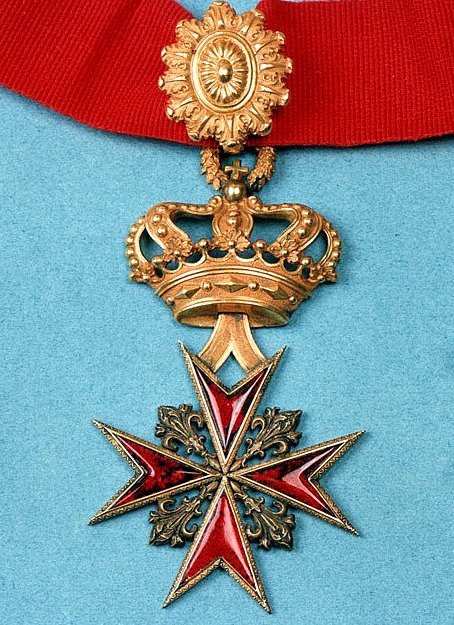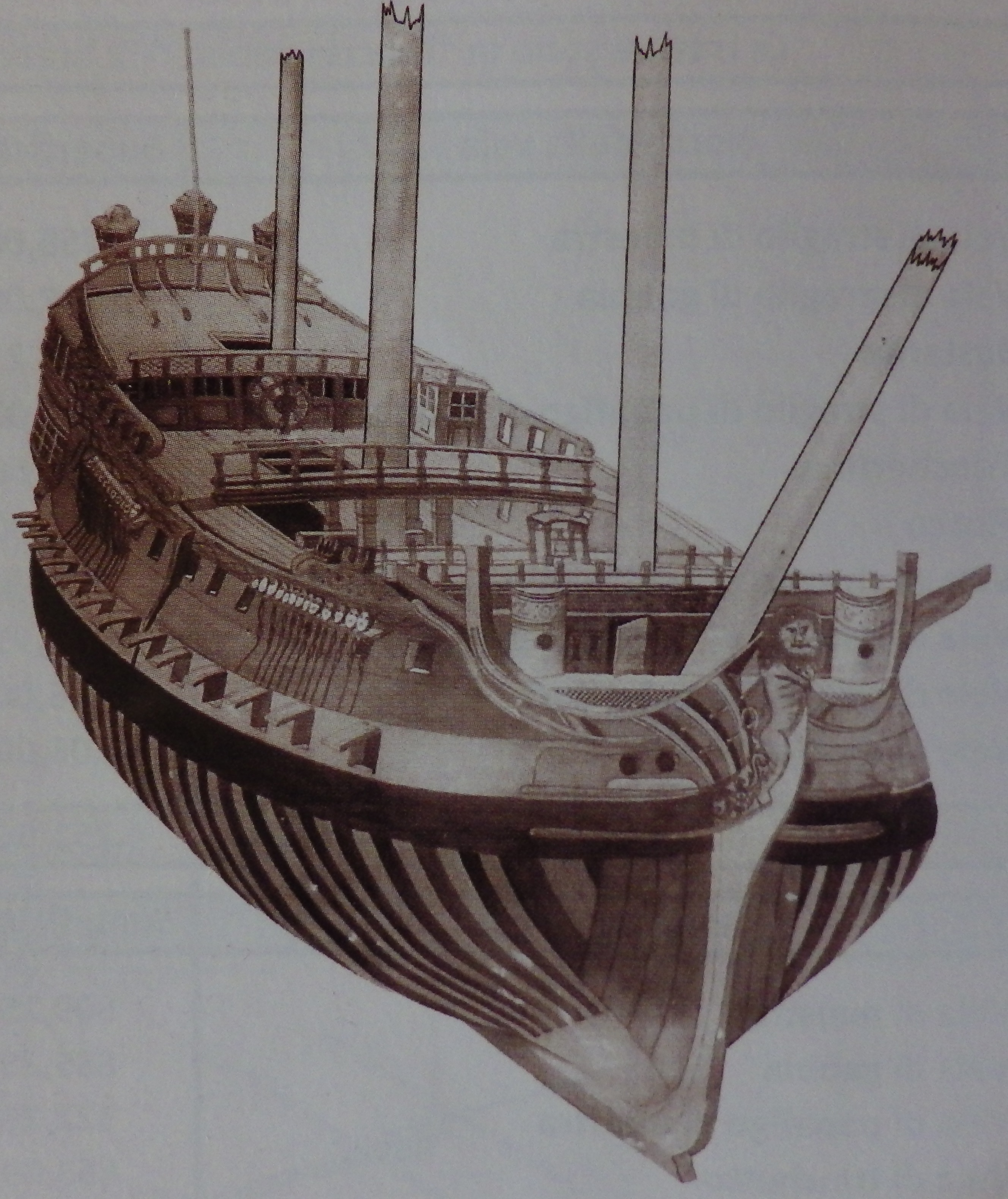|
Action Of July 8, 1716
This indecisive naval battle took place on 8 July 1716 during a Turkish attempt to capture the island of Corfu (Kerkyra), off the west coast of mainland Greece. Background War had been declared between the Ottoman Empire and Venice on 9 December 1714, although it wasn't until June 1715 that a Turkish fleet left the Dardanelles Strait. Soon Venice had been forced out of almost all of the Morea. In 1716, the Turks goal was the capture of the western Greek island of Corfu. This island forms a horseshoe shape, with the two ends close to the Greek mainland, and forms a bay with two narrow entrances. On the island, midway between the two entrances, is the town also called Corfu. Because of the prevailing winds it is difficult for sailing fleets to sail into this bay from the south. The Turkish fleet, under Kapudan Pasha Canum Hoca left the Dardanelles Strait in May 1716 and made its way around the Morea. While keeping his rowed warships in Corfu, the Venetian Captain General of th ... [...More Info...] [...Related Items...] OR: [Wikipedia] [Google] [Baidu] |
Capitano Ordinario Delle Navi
The () was a senior commander of the ships of the line of the navy of the Republic of Venice. History and functions The Venetian navy had traditionally been a galley-based force. The first organized tactical formations of sailing ships began being formed in the late 15th century. The position of was established as the commander of the larger sailing ships built by the Venetian government, but he also assumed control—under the overall authority of the Captain General of the Sea—over all sailing ships in the battle fleet, which were mostly merchant vessels, chartered in Venice or abroad (usually Holland) for naval service. During the 17th century sailing ships of the line began to play a more important role and comprised a larger and larger portion of the Venetian battle fleet, particularly during the War of Candia. The increase in numbers necessitated the creation of more squadrons of sail, initially by the appointment of a second or of a , but on 25 May 1657 two new positio ... [...More Info...] [...Related Items...] OR: [Wikipedia] [Google] [Baidu] |
Order Of Saint Stephen
The Order of Saint Stephen (Official: Sacro Militare Ordine di Santo Stefano Papa e Martire, "Holy Military Order of St. Stephen Pope and Martyr") is a Roman Catholic Tuscan dynastic military order founded in 1561. The order was created by Cosimo I de' Medici, first Grand Duke of Tuscany. The last member of the Medici dynasty to be a leader of the order was Gian Gastone de Medici in 1737. The order was permanently abolished in 1859 by the annexation of Tuscany to the Kingdom of Sardinia. The former Kingdom of Italy and the current Italian Republic also did not recognize the order as a legal entity but tolerates it as a private body. History The order was founded by Cosimo I de' Medici, first Grand Duke of Tuscany, with the approbation of Pope Pius IV on 1 October 1561. The rule chosen was that of the Benedictine Order. The first grand master was Cosimo himself and he was followed in that role by his successors as grand duke. The dedication to the martyred Pope Stephen ... [...More Info...] [...Related Items...] OR: [Wikipedia] [Google] [Baidu] |
Spain
, image_flag = Bandera de España.svg , image_coat = Escudo de España (mazonado).svg , national_motto = ''Plus ultra'' (Latin)(English: "Further Beyond") , national_anthem = (English: "Royal March") , image_map = , map_caption = , image_map2 = , capital = Madrid , coordinates = , largest_city = Madrid , languages_type = Official language , languages = Spanish language, Spanish , ethnic_groups = , ethnic_groups_year = , ethnic_groups_ref = , religion = , religion_ref = , religion_year = 2020 , demonym = , government_type = Unitary state, Unitary Parliamentary system, parliamentary constitutional monarchy , leader_title1 = Monarchy of Spain, Monarch , leader_name1 = Felipe VI , leader_title2 = Prime Minister of Spain ... [...More Info...] [...Related Items...] OR: [Wikipedia] [Google] [Baidu] |
Papal Navy
The Papal Navy ( it, Marina Pontificia, "Pontifical Navy"; la, Classis Pontificiae) was the maritime force of the Papal States. Loosely construed, it was in sporadic existence from approximately the Battle of Ostia (849) during the pontificate of Leo IV until the ascension of Pope Leo XIII in 1878. History Originally protected by the Byzantine navy, the Papal States found themselves in need of a naval force of their own following a Muslim raid on Rome in 843 and the sack of the city's basilicas ''extra muros'' in 846. Under the leadership of Caesar, prince of Naples, a force of Neapolitan, Amalfitan, Gaetan, and Papal ships repulsed the pirates off Ostia in 849. Later, the Papal States subsidized various fleets during the Crusades and outfitted some squadrons of their own, which participated with Venice and others against the Ottoman Empire following the fall of Constantinople. With hired and affiliated ships from Tuscany and Malta, one Papal squadron participated in the B ... [...More Info...] [...Related Items...] OR: [Wikipedia] [Google] [Baidu] |
Knights Hospitaller
The Order of Knights of the Hospital of Saint John of Jerusalem ( la, Ordo Fratrum Hospitalis Sancti Ioannis Hierosolymitani), commonly known as the Knights Hospitaller (), was a medieval and early modern Catholic Church, Catholic Military order (religious society), military order. It was headquartered in the Kingdom of Jerusalem until 1291, on the island of Hospitaller Rhodes, Rhodes from 1310 until 1522, in Hospitaller Malta, Malta from 1530 until 1798 and at Saint Petersburg from 1799 until 1801. Today several organizations continue the Hospitaller tradition, specifically the mutually recognized orders of St. John, which are the Sovereign Military Order of Malta, the Order of Saint John (chartered 1888), Most Venerable Order of the Hospital of Saint John, the Order of Saint John (Bailiwick of Brandenburg), Bailiwick of Brandenburg of the Chivalric Order of Saint John, the Order of Saint John in the Netherlands, and the Order of Saint John in Sweden. The Hospitallers arose ... [...More Info...] [...Related Items...] OR: [Wikipedia] [Google] [Baidu] |
Leon Trionfante-class Ship Of The Line
The ''Leon Trionfante''-class were a class of at least fourteen 70-gun third rate ships of the lineEven if by contemporary British practice these 70-gun ships should be rated as third rates, for the Venetian Navy the ''Leon Trionfante''-class were first rate vessels. This different classification dated back to the previous century, but Venice never changed it for prestige issues. built by the Venetian Arsenale from 1716 to 1785, in four different series with minor changes in the ships' length. In 1797, when Venice fell to the French, Napoleon captured several ships of the class, still unfinished in the Arsenal: he chose one of them, forced the shipbuilders to have it completed and added it to his fleet ''en route'' for Egypt. After Campoformio, the remaining vessels were destroyed by the French to avoid their capture by the Austrian Empire. Design and history Almost all the ships of this class were planned and started before 1739, completed to a 70%, then stored in the roofed sh ... [...More Info...] [...Related Items...] OR: [Wikipedia] [Google] [Baidu] |
Galliot
A galiot, galliot or galiote, was a small galley boat propelled by sail or oars. There are three different types of naval galiots that sailed on different seas. A ''galiote'' was a type of French flat-bottom river boat or barge and also a flat-bottomed boat with a simple sail for transporting wine. Naval vessels * Mediterranean, (16th–17th centuries) : Historically, a galiot was a type of ship with oars, also known as a half-galley, then, from the 17th century forward, a ship with sails and oars. As used by the Barbary pirates against the Republic of Venice, a galiot had two masts and about 16 pairs of oars. Warships of the type typically carried between two and ten cannons of small caliber, and between 50 and 150 men. It was a Barbary galiot, captained by Barbarossa I, that captured two Papal vessels in 1504. * North Sea (17th–19th centuries) : A galiot was a type of Dutch or German merchant ship of 20 to 400 tons ( bm), similar to a ketch, with a rounded fore and aft like ... [...More Info...] [...Related Items...] OR: [Wikipedia] [Google] [Baidu] |
Galleon
Galleons were large, multi-decked sailing ships first used as armed cargo carriers by European states from the 16th to 18th centuries during the age of sail and were the principal vessels drafted for use as warships until the Anglo-Dutch Wars of the mid-1600s. Galleons generally carried three or more masts with a lateen fore-and-aft rig on the rear masts, were carvel built with a prominent squared off raised stern, and used square-rigged sail plans on their fore-mast and main-masts. Such ships were the mainstay of maritime commerce into the early 19th century, and were often drafted into use as auxiliary naval war vessels—indeed, were the mainstay of contending fleets through most of the 150 years of the Age of Exploration—before the Anglo-Dutch wars brought purpose-built ship-rigged warships, ships of the line, that thereafter dominated war at sea during the remainder of the age of sail. Etymology The word ''galleon'' 'large ship' comes from Old French ''galion'' 'arme ... [...More Info...] [...Related Items...] OR: [Wikipedia] [Google] [Baidu] |
Fireship
A fire ship or fireship, used in the days of wooden rowed or sailing ships, was a ship filled with combustibles, or gunpowder deliberately set on fire and steered (or, when possible, allowed to drift) into an enemy fleet, in order to destroy ships, or to create panic and make the enemy break formation. Ships used as fire ships were either warships whose munitions were fully spent in battle, surplus ones which were old and worn out, or inexpensive purpose-built vessels rigged to be set afire, steered toward targets, and abandoned quickly by the crew. Explosion ships or "hellburners" were a variation on the fire ship, intended to cause damage by blowing up in proximity to enemy ships. Fireships were used to great effect by the outgunned English fleet against the Spanish Armada during the Battle of Gravelines, [...More Info...] [...Related Items...] OR: [Wikipedia] [Google] [Baidu] |
Patron Delle Navi
The , also or , was a squadron commander of the ships of the line of the navy of the Republic of Venice. History Although it began using ailing ships in its battle line during the 15th century, the Venetian navy had traditionally been a galley-based force. During the 17th century sailing ships of the line began to play a more important role and comprised a larger and larger portion of the Venetian battle fleet, particularly during the War of Candia. The increase in numbers necessitated the creation of more squadrons of sail, and thus on 25 May 1657 two new positions, the and the were created to command the second and third sailing ship divisions, while a commanded the first division. The term or meant 'skipper', especially of galleys, but was also frequently applied to ships, especially the ship next in rank to the flagship (the ). Thus the title of has the meaning of 'vice-admiral of the ships'. Appointment to the post was usually for three years. As distinctive signs ... [...More Info...] [...Related Items...] OR: [Wikipedia] [Google] [Baidu] |




